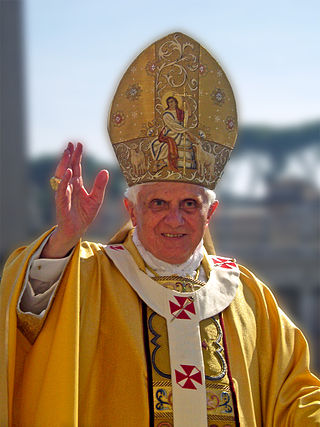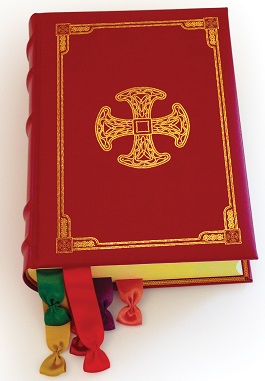
The Anglican Use, also known as Divine Worship, is a use of the Roman Rite celebrated by the personal ordinariates, originally created for former Anglicans who converted to Catholicism while wishing to maintain "aspects of the Anglican patrimony that are of particular value" and includes former Methodist converts to Catholicism who wish to retain aspects of Anglican and Methodist heritage, liturgy, and tradition. Its most common occurrence is within parishes of the personal ordinariates which were erected in 2009. Upon the promulgation of Divine Worship: The Missal, the term "Anglican Use" was replaced by "Divine Worship" in the liturgical books and complementary norms, though "Anglican Use" is still used to describe these liturgies as they existed from the papacy of John Paul II to present.
The hierarchy of the Catholic Church consists of its bishops, priests, and deacons. In the ecclesiological sense of the term, "hierarchy" strictly means the "holy ordering" of the church, the Body of Christ, so to respect the diversity of gifts and ministries necessary for genuine unity.

The Book of Divine Worship (BDW) is an adaptation of the American Book of Common Prayer (BCP) by the Catholic Church. It was used primarily by former members of the Episcopal Church within Anglican Use parishes of the Pastoral Provision and the Personal Ordinariates. It has been replaced by a new book to be used worldwide, titled Divine Worship: The Missal.
In Christianity, the term secular clergy refers to deacons and priests who are not monastics or otherwise members of religious life. Secular priests are priests who commit themselves to a certain geographical area and are ordained into the service of the residents of a diocese or equivalent church administrative region. That includes serving the everyday needs of the people in parishes, but their activities are not limited to that of their parish.

Latin liturgical rites, or Western liturgical rites, is a large family of liturgical rites and uses of public worship employed by the Latin Church, the largest particular church sui iuris of the Catholic Church, that originated in Europe where the Latin language once dominated. Its language is now known as Ecclesiastical Latin. The most used rite is the Roman Rite.

The Anglican Church in America (ACA) is a Continuing Anglican church body and the United States branch of the Traditional Anglican Church (TAC). The ACA, which is separate from the Episcopal Church (TEC), is not a member of the Anglican Communion. It comprises five dioceses and around 5,200 members.

In the Catholic Church, a bishop is an ordained minister who holds the fullness of the sacrament of holy orders and is responsible for teaching doctrine, governing Catholics in his jurisdiction, sanctifying the world and representing the Church. Catholics trace the origins of the office of bishop to the apostles, who it is believed were endowed with a special charism and office by the Holy Spirit at Pentecost. Catholics believe this special charism and office has been transmitted through an unbroken succession of bishops by the laying on of hands in the sacrament of holy orders.
In the Catholic Church, a parish is a stable community of the faithful within a particular church, whose pastoral care has been entrusted to a parish priest, under the authority of the diocesan bishop. It is the lowest ecclesiastical subdivision in the Catholic episcopal polity, and the primary constituent unit of a diocese or eparchy. Parishes are extant in both the Latin and Eastern Catholic Churches. In the 1983 Code of Canon Law, parishes are constituted under cc. 515–552, entitled "Parishes, Pastors, and Parochial Vicars."

John Charles Broadhurst is an English priest of the Roman Catholic Church. Broadhurst was formerly a bishop of the Church of England and served as the Bishop of Fulham in the Diocese of London from 1996 to 2010. He resigned in order to be received into the Roman Catholic Church and became a priest in that church in 2011.
David Lloyd Moyer is a former American bishop. He was a priest of the Episcopal Church before becoming a bishop of the Anglican Church in America, a Continuing Anglicanism body. After being deposed from the Episcopal Church and denied entry into the Roman Catholic Church as a cleric in 2012, in 2014 he was received as a layman. His former congregation, then known as the Blessed John Henry Newman Catholic Community of Strafford, Pennsylvania, prepared to enter the Personal Ordinariate of the Chair of St. Peter, the North American ordinariate for former Anglicans. The community later merged with a second local Anglican ordinariate group to form St. John the Baptist Catholic Church in Bridgeport, Pennsylvania.

Pope Benedict XVI, who led the Roman Catholic Church as Pope from 2005 to 2013, continued manouevring the Church through the dynamics of modernity, which the Church had begun engaging in with the Second Vatican Council. Because the question of religious pluralism is a key issue raised by modernity, ecumenism, the establishment of harmony and dialogue between the different Christian denominations, is a significant concern of a post Second Vatican Council Church. Pope Benedict XVI's approach has been characterised as leaning toward the conservative while still being expansive and engaged, involving the full breadth of Christendom, including the Orthodox Churches and Protestant churches, as well as freshly engaging with other Christian bodies considered by Roman Catholics to be more heterodox, such as the Church of Jesus Christ of Latter-day Saints.
A personal ordinariate for former Anglicans, shortened as personal ordinariate or Anglican ordinariate, is a canonical structure within the Catholic Church established in order to enable "groups of Anglicans" and Methodists to join the Catholic Church while preserving elements of their liturgical and spiritual patrimony.
This is a glossary of terms used within the Catholic Church. Some terms used in everyday English have a different meaning in the context of the Catholic faith, including brother, confession, confirmation, exemption, faithful, father, ordinary, religious, sister, venerable, and vow.

The Personal Ordinariate of Our Lady of Walsingham in England and Wales is a personal ordinariate in the Latin Church of the Catholic Church immediately exempt, being directly subject to the Holy See. It is within the territory of the Catholic Bishops' Conference of England and Wales, of which its ordinary is a member, and also encompasses Scotland. It was established on 15 January 2011 for groups of former Anglicans in England and Wales in accordance with the apostolic constitution Anglicanorum coetibus of Pope Benedict XVI, which was supplemented with the Complementary Norms of Pope Francis in 2013.

The Personal Ordinariate of the Chair of Saint Peter is a Latin Church ecclesiastical jurisdiction or personal ordinariate of the Catholic Church for Anglican converts in the United States and Canada. It allows these parishioners to maintain elements of Anglican liturgy and tradition in their services. The ordinariate was established by the Vatican in 2012.

The Personal Ordinariate of Our Lady of the Southern Cross is a personal ordinariate of the Latin Church of the Catholic Church primarily within the territory of the Australian Catholic Bishops' Conference. It is organized to serve groups of Anglicans who desire full communion with the Catholic Church in Australia and Asia. Personal ordinariates, like military ordinariates and dioceses, are immediately subject to the Holy See in Rome. The motto of the ordinariate is Mea Gloria Fides. The current apostolic administrator is Anthony Randazzo, who succeeded the second ordinary, Carl Reid, in 2023.

The Cathedral of Our Lady of Walsingham in Houston, Texas, is a Catholic church that serves as the cathedral of the Personal Ordinariate of the Chair of Saint Peter.

Steven Joseph Lopes is an American Catholic prelate. He is the bishop and ordinary of the Personal Ordinariate of the Chair of Saint Peter, a community for clergy and laypeople who celebrate according to the Anglican Use within the Catholic Church.

Divine Worship: The Missal (DW:TM) is the liturgical book containing the instructions and texts for the celebration of Mass by the former Anglicans within the Catholic Church in the three personal ordinariates of Great Britain, United States and Canada, and Australia. The rite contained in this missal is the Anglican Use, a liturgical use of the Roman Rite Mass with elements of Anglican worship. It was approved for use beginning on the first Sunday of Advent, November 29, 2015.












